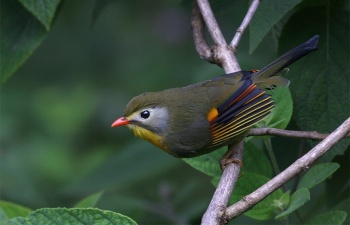
Photo © by Alok Tewari
Sat Tal Forest, Alt. 5000 ft., Uttarakhand Himalayas, India, 18 October 2018
Alternative names: Pekin Robin; Peking Robin; Red-billed Mesia
- Leiothrix lutea
Identification
14 - 15cm (5½-6 in), A small compact and unmistakable Babbler3:
- Mostly greyish-olive
- Short red bill with dark base
- Pale face and lores is yellowish buff in most subspecies
- Yellow throat
- Notched black tail with flared tips
- Uppertail coverts long, white-tipped
- Variable yellow or orange markings on wings
Female: more greenish-brown, greyer ear-coverts, weaker submoustachial stripe, paler below. Immature is similar to female but with less vibrant colours including a less red bill.
Variations
- kumaiensis: has a greener crown with less of a yellowish wash than nominate. Wing-patches consists of orange-red distal outer fringes of inner primaries and an orange patch at base of the secondaries
- calipyga is similar to kumaiensis but yellower above, with orange-red fringes of inner primaries extending the entire length of the feathers
- yunnanensis is similar to kumaiensis above but overall paler, with lores and ocular area are whitish; chin to breast is paler and the wing lacks red or orange colouring
- kwangtungensis: similar to nominate, but yellower on nape, crown, face, sides of neck and underparts. Rear end of upperparts are more olive-toned. Wing markings consists of an orange patch at base of secondaries
- lutea: this, the nominate form, has yellowish-buff face, wings with a large chestnut-red basal patch on primaries and yellow to orange yellow edgings on the rest of the primaries, as well as a small yellow area at the base of the secondaries
Distribution
Found in the Himalayas, N Burma, N Vietnam and S, SC and E China.
Common in parts of its range, but scarce and declining in others due to heavy trading as cagebirds.
Introduced populations on the Hawaiian Islands, where it exhibits dramatic and unexplained population fluctuations. There are small but thriving populations of escapees in Japan since the 1980s. Furthermore small populations got established in Germany, Italy, France, Spain, Portugal, and on Reunion Island.1
Taxonomy
Subspecies
Clements2 accepts five subspecies:
- L. l. kumaiensis in the North West Himalayas (North East Pakistan to North India)
- L. l. calipyga in the Himalayas from West Nepal over Sikkim, Bhutan, the northeastern India hill states, southern China (southeastern Xizang), and extreme northwestern Myanmar (possibly south to the northern Chin Hills)
- L. l. yunnanensis from North East Myanmar to South China (Yunnan)
- L. l. kwangtungensis in South and South East China (South East Yunnan, Guangxi, Hunan and Guangdong) and North Vietnam
- L. l. lutea in South-central and East China (Gansu, Shaanxi, Hubei, Anhui, Zhejiang, Fujian, Sichuan, Guizhou and Guangxi)
The subspecies luteola is no longer accepted and instead is included in calipyga. Furthermore the Doubtful Leiothrix L. (l.) astleyi, known from a pair of birds shipped from S China is now considered to represent mutated cagebirds.
Habitat
Undergrowth of open broadleaf forest, mixed forest, forest edge, secondary growth, scrub, tea plantations, abandoned cultivation. Primarily between 900 and 2400m.1
Behaviour
Diet
Feeds on insects but takes also berries and fruit.
During the breeding season in pairs, outside in groups of 4 - 6 individuals (bigger groups possible), often associating with other species in birdwaves.
Breeding
Breeding season generally from April to October, varying through range. The nest is an oval cup, built by the female with grasses, dead bamboo and other leaves. It's placed in bush or bamboo, close to the ground (0.6 to 1.5m). Lays 3 - 5 eggs, the incubation period is 11 - 14 days.
Movements
Resident species with some altitudinal movement in the Himalayas.1
References
- Del Hoyo, J, A Elliott, and D Christie, eds. 2007. Handbook of the Birds of the World. Volume 12: Picathartes to Tits and Chickadees. Barcelona: Lynx Edicions. ISBN 978-8496553422
- Clements, J. F., T. S. Schulenberg, M. J. Iliff, S. M. Billerman, T. A. Fredericks, J. A. Gerbracht, D. Lepage, B. L. Sullivan, and C. L. Wood. 2021. The eBird/Clements checklist of Birds of the World: v2021. Downloaded from https://www.birds.cornell.edu/clementschecklist/download/
- Rasmussen, P. C. and Anderton, J. C. 2005. Birds of South Asia. The Ripley Guide. Washington and Barcelona. Smithsonian Institute and Lynx Edicions. ISBN 84-87334-67-9
- Birdforum thread discussing presence in Europe (post 36 and those following)
- Handbook of the Birds of the World Alive (retrieved Nov 2017 and Apr 2018)
- Craig Robson Field guide to the birds of SE Asia
- Birdforum thread discussing ID of females and subspecies
Recommended Citation
- BirdForum Opus contributors. (2025) Red-billed Leiothrix. In: BirdForum, the forum for wild birds and birding. Retrieved 9 May 2025 from https://www.birdforum.net/opus/Red-billed_Leiothrix
External Links
GSearch checked for 2020 platform.1






